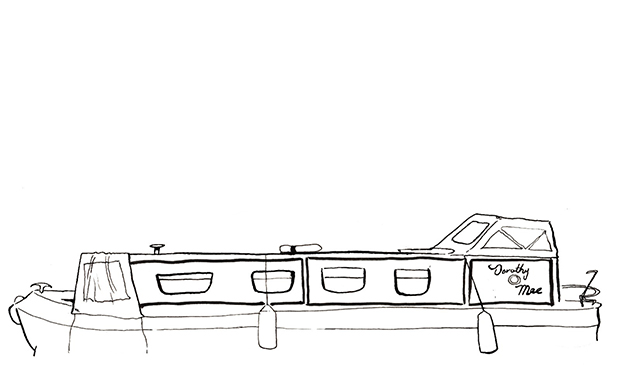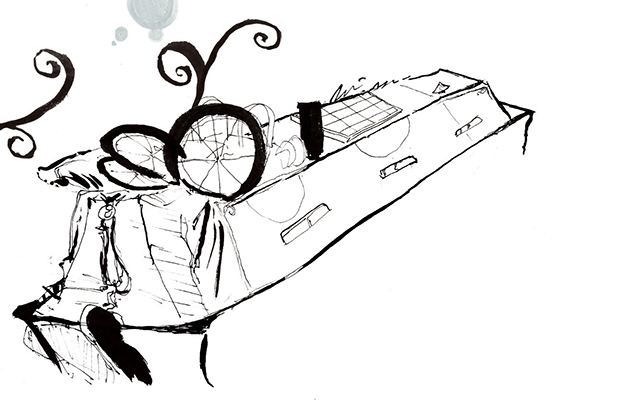The Citizen Gardener: Home on the water?

Illustration: Zack Bottoni / zackbottoni.com / @zackbot
I think living in London works really well, but only if you’re rich or you’re poor.
There’s a weird middle ground, where you can work your arse off and still find it a struggle. You’re not of use, not feeding the beast that be.
The fundamentals – roof over the head and food in the belly – are constantly getting more expensive.
The three pillars of life, as a good friend so clearly outlined to me on my arrival in London at 19 years old, are: health (that’s numero uno apparently); wealth (earn money); and home (successfully cover the two above to pay for a place to live.
This would maintain my stay. For the time being at least. It was fairly obvious advice, but easily overlooked at that age.
What about being a ‘creative’ though? What if you have a martyr complex or are some kind of artist? It’s a scary time for that. A move to the ‘big smoke’ may no longer quench the thirst, sadly.
And what happens should you want more than to just stay in London? What if you want to stay stay. You might even have the ludicrous idea of buying a flat, or even a house, here in Hackney. Perhaps try to nab one of those new-build concrete rabbit hutches for office workers? Buy it at a premium before you’ve seen it finished, or before it’s even been built.
What do you do if you want to own your home but can’t afford bricks and mortar? If you’ve followed the shake-it-up, make-it-up path I have, then you’re probably fucked – at least when it comes to buying here.
If you are lucky enough to have found a spouse, partner, girlfriend, boyfriend, forever friend in this traffic coagulation of joy, pollution and toil, you might just be in with a chance. As long as you’re not both self-employed or creative. That can be problematic. The city will allow one of you a free pass. Not both.
The good times happen in Hackney though, and they happen often enough for my girlfriend and I not to bugger off to Hastings – a bang-for-ya-buck idea that we explored very recently.
A term the locals in East Sussex use for people that have made the move from London is ‘FILTH’, a beautifully funny acronym that stands for ‘failed in London, try Hastings’.
Another option for those looking to succeed in London is to live on a boat – one taken up by the many people who have made their homes on the River Lea and its neighbouring waterways.
There is some romanticism around this lifestyle, especially among the canalside pedestrians who often sneak a peek into the barges.
But what is it really like? What are the cistern tank truths, the gate-kept unknowns from the murky lochs?

Illustration: Zack Bottoni / zackbottoni.com / @zackbot
After some planting I did recently on the top of his narrowboat, Robbie, a friend of mine, agreed to answer a few of my burning questions about life on the water. Here’s how it went:
Dan: Thanks for your time today! I’d like to start by asking how you ended up living on a boat? Were you renting in London before?
Robbie: My partner and I moved in during the pandemic. We had friends who had lived on boats before and had a little bit of experience. Plus with work drying up we had plenty of time to do the research.
We’d been renting the same flat in north London for seven years but felt like we wanted a change, and a space we had some agency over. Anything we looked at that had a decent leasehold length was too expensive for us to be able to get a mortgage for – unless we had specifically got a buy-to-let mortgage. My partner and I were both freelance at the time and for some reason a mortgage adviser told us they would have let us take out one of those, but they couldn’t lend us the money for us to live there ourselves.
Dan: What’s been the hardest thing about living on a boat? Do you feel connected to your fellow boaters and the boating community?
Robbie : I think getting through the winters is the toughest part. It can certainly be cosy with a stove running, but it is work to keep that stocked and warm.
We rely on solar panels for energy, so when the nights start drawing in you have to rely on other energy sources, like running your engine, or some people have generators.
I know around Victoria park there have been local petitions to stop boats running their engines or stoves. I understand it from an air pollution angle – it can make you feel a little self-conscious, especially if you have to run it after dark when getting in from work to charge your batteries.
If I’m totally honest, I’m pretty sure our total energy usage would be much lower than those who live in the flats nearby, but I acknowledge it’s always easy to rationalise these things away.
It gets much easier around this time of year though – more daylight means more solar energy to charge our batteries, plus more light throughout the boat. We’re usually slightly lower than street level on the water, and during the winter it can be very dark.
On the other side, in the summer, we’re cooking away in a big steel tube that can be a little much when it’s over 30 degrees.
I certainly feel much more connected to the seasons than I ever did living in a flat.
The sense of community mainly comes from boaters’ efforts to resist changes made by the Canal and River Trust, which we pay our licence fees to.
In the five years we’ve lived aboard, we’ve seen costs increase, facilities removed and the amount of mooring space reduced in favour of bookable, pay-per-night moorings. These were instated in previously free spaces in King’s Cross and Angel – some of the few places an electricity hook-up is available – from early last year, and have been threatened in the areas around Victoria Park. But it looks like, for the moment, that has ground to a halt.
Dan: I recently came to help you and your partner plant some seeds to enhance and add to your two vegetable planters. You’ve had great success in the past. What have you harvested? What’s been a success? And do you have any tips for growing your own food on the roof of a boat?
Robbie : Courgettes, mini cucumbers, kale and beetroot – we tried chantenay carrots but it wasn’t deep enough and they were super small.
Cats climbing into the beds and digging them up has been a massive pain – as much as I love cats – so I’ve fashioned some kindling bags into nets across the top of the boxes which seem to be doing the trick!
The biggest challenge is the inconsistency of the environment. Light levels change all the time and generally it’s pretty exposed.
Also water – we didn’t do tomatoes this year as they need so much water! We’ve sadly had the same issues with strawberries – they’re so thirsty! Under the cratch cover is a good replacement greenhouse for seedlings, but again we get inconsistent light.
Our kale re-seeded itself, so we had two years’ worth, and I also harvested some seeds which was good!
This year, we’re hoping to keep the weeds under control. Because it’s so exposed, seeds blow across and end up in the soil.
But we love growing our own food and can’t wait to see the fruits of our labour this summer.
Daniel Burke is a trained gardener with almost 10 years’ experience. He is a founder of a community interest company The Hackney Flower Show, which aims to renovate public spaces and create an annual community event celebrating the borough’s horticulture.
